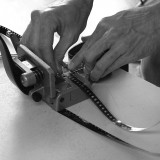Hyperfocus
By Chris Bailey
Disconnecting is one of the most powerful ways to spark new and innovative ideas.
I learned that one of the best practices for fostering my creativity and productivity was learning how to unfocus.
Seven ways to focus more deeply while reading.
1. PUT YOUR PHONE OUT OF SIGHT
By noting the times you habitually reach for your phone, you’ll gain insight into which tasks you resist the most and how you’re feeling in those moments.
2. MIND YOUR ENVIRONMENT
3. MAKE A DISTRACTIONS LIST
Ask yourself: After consuming one of those products, will you be happy with how you invested your time and attention?
Just as you are what you eat, you are what you pay attention
And just as you’ve kept a distractions list while you read, make sure you have a place to capture ideas that come to mind during your break.
As many as 40 percent of our actions are habits, which shouldn’t require conscious deliberation.
But some decisions are worth making deliberately. How we manage our attention is one of them.
(One of the most underrated skills: letting other people finish their sentences before starting yours.)
… throughout the day, how frequently do you choose what to focus on?
In other words, roughly how much of your time do you spend deliberately and with intention, deciding in advance what you want to do and when you’ll do it?
The more we can manage our attention with intention, the more focused, productive, and creative we become.
The most urgent and stimulating things in your environment are rarely the most significant. This is why switching off autopilot mode is so critical. Directing your attention toward the most important object of your choosing—and then sustaining that attention—is the most consequential decision we will make throughout the day. We are what we pay attention to.
There are two main criteria to consider when categorizing what to focus on:
whether a task is productive (you accomplish a lot by doing it) and
whether a task is attractive (fun to do) or unattractive (boring, frustrating, difficult, etc.).
“Attentional space” is the term I use to describe the amount of mental capacity we have available to focus on and process things in the moment.
Becoming aware of what you’re thinking about is one of the best practices for managing your attention. The more you notice what’s occupying your attentional space, the faster you can get back on track when your mind begins to wander, which it does a remarkable 47 percent of the time.
This is essentially what mindfulness is—noticing what your mind is full of: what you’re thinking, feeling, and perceiving at any given moment. Mindfulness adds another important dimension to the mix: not judging what you’re thinking about.
“All thoughts want to be taken seriously, but few warrant it.”
David Cain
Simply noticing what is occupying our attentional space has been shown to make us more productive.
There are two kinds of tasks in our life and work: habits, which we can perform without much thought and require minimal attentional space, and complex tasks, which can be done well only with dedicated focus.
Many experts argue that we can’t multitask, which is often true for tasks that require focus to do properly and thus occupy a larger amount of attentional space. But the same is not true for habits—in fact, we’re able to multitask surprisingly well with habits.
Every Sunday I like to lump my personal, relatively rote “maintenance tasks” together—tasks that help me maintain who I am, like preparing meals, trimming my nails, and cleaning the house—and do them all in an allotted period of time while listening to podcasts or an audiobook.
…your most necessary and purposeful tasks can’t be done out of habit. This is exactly what makes these tasks so productive.
You accomplish more in doing them because they require focus and brainpower and take advantage of unique skill
This is one of the many reasons why distracting tasks are so costly: while these tasks are attractive and stimulating (think watching Netflix after a long day at the office instead of grabbing dinner with a friend), they steal precious time from your most productive work.
Spending time on our most productive tasks means we usually have very little attention to spare—if there’s any left at all.
At any one time, your attentional space should hold at most two key things that you are processing: what you intend to accomplish and what you’re currently doing.
If you find yourself responding to important work in autopilot mode, chances are you’re trying to cram too much into your attentional space.
The best way to avoid this overload is to be more selective with what you permit into your attentional space.
Compounding this is the fact that the brain’s prefrontal cortex—the large part of the forebrain that lets us plan, think logically, and get work done—has a built-in “novelty bias.” Whenever we switch between tasks, it rewards us with dopamine
Continually seeking novel stimuli makes us feel more productive—after all, we’re doing more in each moment. But again, just because we’re busier doesn’t mean we’re getting more accomplished.











